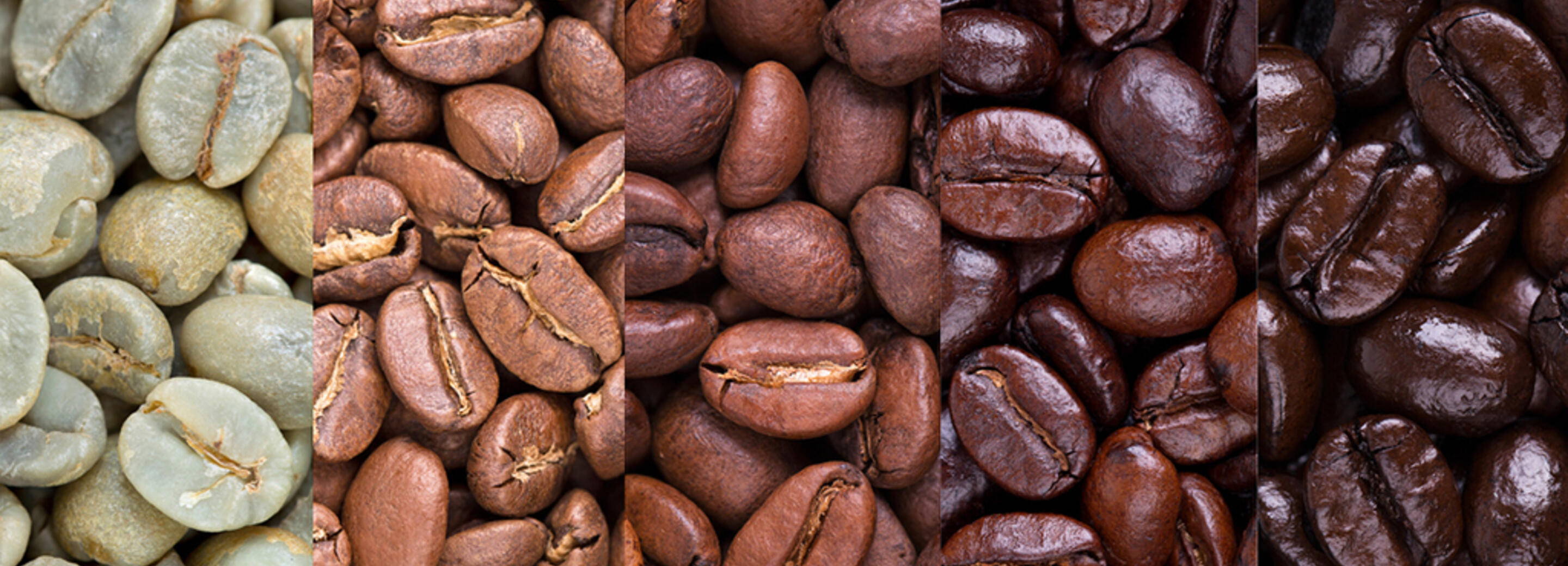
Here’s where our coffee talks get really interesting.
It’s one thing to know the terroir and processing method. However, that kind of information is sometimes not readily available unless you do your research or source your beans from a roaster who provides that info on the coffee bag. One thing that you can assess for yourself, though, is choosing the roast level of your coffee beans.
How Does Roasting Affect Your Coffee?
Before we get to the different types of roast levels, let’s first understand what roasting does to the coffee we drink.
To put it simply, roasting unlocks the flavor and aroma of the coffee beans. They start off as greenish-colored beans that have little or no taste and possibly a earthy-plant smell. These green beans are then roasted at very high temperatures, which emulsify and caramelize the stored sugars, starches, and fats. After roasting, the beans now have that unmistakable coffee aroma and have turned into a shade of brown. These are what end up being sold to coffee drinkers like you and are ready to be ground and brewed as desired.
Roasting 101: Defining the Stages of the Roasting Process

Image from Barista Institute
Roast levels are defined by the chemical reactions that happen to the beans at certain temperatures. As the temperature increases during roasting, variables like acidity, flavor, and aroma are enhanced and changed, which directly affects the overall body of your coffee. Let’s take a look at the 5 different stages of roasting and how it brings out certain flavors from the beans.
1. Maillard Reaction
The Maillard Reaction is synonymous with the transition of green-colored coffee beans into light brown (also known as “browning phase”), which would include several chemical reactions that happen in between. For coffee beans, Maillard Reaction is the stage where sugars and proteins are subjected to heat (around 150 - 200°C/302 - 392°F), which then creates the flavors and colors that are characteristic of coffee.
2. Caramelization
Once we hit 170 - 200°C (338 - 392°F), the sugars in the coffee begin to caramelize, which releases unique aromatic and acidic compounds. Caramelization is part of the Maillard Reaction, which most experts would agree is vital in achieving the desired roast and flavor profiles. This is why it’s very crucial to control the length of the Maillard Reaction — from when it starts and how long it lasts.
3. First Crack
When temperature hits 205°C (401°F), the beans undergo what we call the “first crack,” which is caused by vaporization of the water inside the bean. This causes a physical and audible crack that also makes the beans double in size. Around this time is where light roasts are formed, which gives off a sweeter, fruitier flavor profile.
4. Pyrolysis
Somewhere in between the first and second crack is a process called “pyrolysis.” This happens at around 220°C (428°F), where carbon dioxide is released from the beans, volatile compounds are produced, and oils start to develop on the surface. The color of the beans turns into medium brown and loses 13% of its weight.
5. Second Crack
As pyrolysis continues and reaches a temperature range of 225 - 230°C (437-446°F), the second crack occurs. This is where the cellulose in the cell wall of the bean breaks apart and results in a medium-brown color and an oily sheen. During this stage, more of the coffee’s aroma is released, which delivers a more full bodied flavor.
Knowing these stages of the roasting process and the associated chemical reactions can help you in identifying which coffee beans to choose.
There is a progression that happens, which you can also study using SCA’s Coffee Taster's Flavor Wheel. As coffee beans are roasted to a light shade of brown, you get the sweeter and fruitier spectrum of flavor profiles. And as you get to longer roasting periods that turn the beans into darker shades of brown, this is when you also get fuller flavors that can be more bitter and smokier.
Having these insights gives you an idea of how the roasting process relates to the flavors and notes of the coffee you drink (which you can also see on most specialty coffee packaging).

Say hello to your new coffee e-zine for the most interesting news, tips, and trends in the world of coffee.
4 Types of Coffee Roast Levels

Image from Barista Institute
It might sound easy enough to heat up the beans to get the roast that you want, but being an expert roaster actually requires a substantial level of technical skill that combines science and art. In fact, it normally takes years of training to be able to reach the level where you can get perfectly roasted beans by “reading” the beans and making split-second decisions.
It’s important to note that getting the “perfect” roast is subjective. This is where the varying levels of roasts come into play. Most specialty roasters may have their own terms and names for the type of roast that they do but it all generally falls under these 4 primary levels.
1. Light Roast

Image from Coffee Affection
Temperature: 176 - 210°C (350 - 410°F)
Other Names: New England, Half City, Light City, Cinnamon
Light roasts deliver bright flavors, crisp acidity, and light body. As its name suggests, these beans have a light brown color and don't have oil on the surface. Lightly roasted beans also retain the most caffeine and acidity compared to other roast levels because they’re not exposed to high enough temperatures that would pull away caffeine and acidity from the beans.
That said, light roasts do have varying taste profiles because the short roasting process allows the bean to retain much of its original flavors. Light roast is perfect for you if you’re looking to have that vibrant and unique flavor to your coffee paired with a bit of lemon or citrus-y notes due to the higher acidity.
If you’re new to specialty coffee, light roasts tend to be a more acquired taste because most coffee drinkers aren’t used to the ‘sour’ flavor associated with lighter roasted coffees–but if you’re feeling adventurous and are open minded to experiencing the ‘fruitier’ side of coffee (stone fruit, apple, orange, pineapple, etc), there’s a whole new world of flavor waiting for you.
2. Medium Roast

Image from Coffee Affection
Temperature: 210 - 227°C (410 - 440°F)
Other Names: City, Regular, American
If light roast only reaches up until the ‘first crack’ of the beans, medium roast occurs between the ‘first crack’ and the ‘second crack’. Given higher roasting temperatures, these beans have a bit more body and have less acidity than light roast giving a more balanced overall flavor.
Medium roast is also characterized by being heavily favored in the United States, hence being also known as American roast. For most beginner coffee drinkers, medium roast is the most preferred as it’s considered less intense than light roast but it still retains most of the coffee’s unique and natural flavor profile.
3. Medium-Dark Roast

Image from Coffee Affection
Temperature: 227 - 232°C (440 - 450°F)
Other Names: Continental, Viennese, Full City, Light French, Light Espresso
There’s a small window between medium and dark roasts that’s well worth noting because of its unique flavor profile. Medium-dark roast is achieved during or right after the second crack, giving a richer and fuller flavor and body.
Unlike light and medium roasts, medium-dark roasted beans will have some oil on the surface, which has been pulled out from the inside of the bean, because of the higher temperature and longer roasting period. That said, you may not be able to distinguish the beans’ original flavor anymore – flavor notes that are attributable from the terroir are lost and the remaining flavors come purely from the roasting process (i.e.tobacco, smoky, pepper, nutmeg). Since these flavors are ‘heavier’, they tend to overpower the ‘lighter’ flavors that are naturally occurring in the bean.
4. Dark Roast

Image from Coffee Affection
Temperature: 226 - 249°C (440 - 480°F)
Other Names: French, Espresso, Turkish, Italian, Dark French, Heavy
On the other end of the spectrum is dark roast, which is preferred more in Europe. Dark roasted beans have visible oil on the surface and have no traces of the beans’ original flavor. However, just because you can’t taste the original flavor doesn’t mean dark roasted beans are bland.
Those who prefer dark roasts are coffee drinkers who like their coffee chocolatey, nutty, and caramel-y. Dark roast also tends to be more common among commercial roasters (like Starbucks and McDonalds) because it hides defects and creates greater consistency between coffee sourced from different farms that are blended into the same batch; this is how large coffee chains are able to get that consistent flavor across all their shops.
Fun fact: the French roast is considered the darkest roast there is with a roasting temperature of 482°F, giving that pronounced smoky flavor. Just take note, however, that anything roasted beyond that temperature would just burn the oils and sugar of the beans away (that would be considered ‘burnt’ coffee rather than dark roast).
Given the level of expertise of professional roasters these days, you can definitely expect to encounter an even wider variety of roasting levels.
While it can be rather confusing and overwhelming at times, we highly recommend exploring specialty coffee beans from each of these 4 primary roast types as a starting point. You can choose to taste them in succession or perhaps try light and then dark in the same sitting to understand the nuances. You’d be surprised by the stark differences in flavor and aroma of each roast, even if it’s the exact same bean. This adds to the beautiful spectrum of possible flavors you can encounter in coffee, and as always we encourage you to give them all a try to see which you enjoy more (you won’t know until you try 😉).



